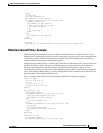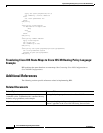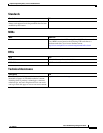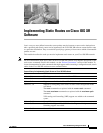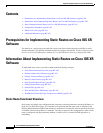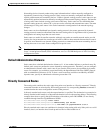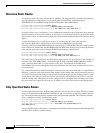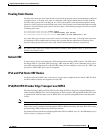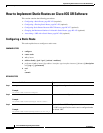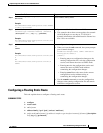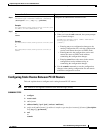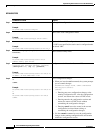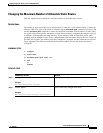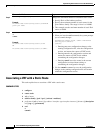
Implementing Static Routes on Cisco IOS XR Software
Information About Implementing Static Routes on Cisco IOS XR Software
RC-423
Cisco IOS XR Routing Configuration Guide
OL-14356-01
Floating Static Routes
Floating static routes are static routes that are used to back up dynamic routes learned through configured
routing protocols. A floating static route is configured with a higher administrative distance than the
dynamic routing protocol it is backing up. As a result, the dynamic route learned through the routing
protocol is always preferred to the floating static route. If the dynamic route learned through the routing
protocol is lost, the floating static route is used in its place. The following example shows how to define
a floating static route:
RP/0/RP0/CPU0:router(config)# router static
RP/0/RP0/CPU0:router(config-static)# address-family ipv6 unicast
RP/0/RP0/CPU0:router(config-static-afi)# 2001:0DB8::/32 2001:0DB8:3000::1 210
Any of the three types of static routes can be used as a floating static route. A floating static route must
be configured with an administrative distance that is greater than the administrative distance of the
dynamic routing protocol because routes with smaller administrative distances are preferred.
Note By default, static routes have smaller administrative distances than dynamic routes, so static routes are
preferred to dynamic routes.
Default VRF
A static route is always associated with a VPN routing and forwarding (VRF) instance. The VRF can be
the default VRF or a specified VRF. Specifying a VRF, using the vrf vrf-name command, allows you to
enter VRF configuration mode for a specific VRF where you can configure a static route. If a VRF is not
specified, a default VRF static route is configured.
IPv4 and IPv6 Static VRF Routes
An IPv4 or IPv6 static VRF route is the same as a static route configured for the default VRF. The IPv4
and IPV6 address families are supported in each VRF.
IPv6/IPv6 VPN Provider Edge Transport over MPLS
IPv6 Provider Edge (6PE) and IPv6 VPN Provider Edge (6VPE) leverages the existing Multiprotocol
Label Switching (MPLS) IPv4 core infrastructure for IPv6 transport. 6PE and 6VPE enables IPv6 sites
to communicate with each other over an MPLS IPv4 core network using MPLS label switched paths
(LSPs).
Note This feature is supported on Cisco XR 12000 Series Routers.
Static routes can be configured under the default VRF for 6PE functionality and under IPv6 VPN routing
and forwarding (VRF) instances for 6VPE functionality.
For detailed information about configuring 6PE and 6VPE over MPLS, see Cisco IOS XR Multiprotocol
Label Switching Configuration Guide.



